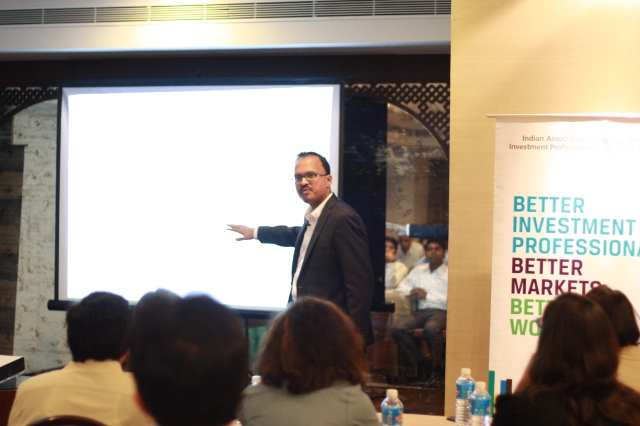- September 8, 2015
- Posted by:
- Category:Bengaluru, BLOG, Events, Speaker Events
Contributed by: Aneek Saha, CFA
Indian Association of Investment Professionals – Bengaluru, had a interesting session on The Goods & Services Tax (GST), wherein K. Baskar, Director, Indirect Taxation, Deloitte, gave insights into proposed legislation and benefits. The implementation of the GST could decrease paperwork, increase compliance and potentially bump up the GDP of the country by 1.4%. The following is a brief overview of the event.
The Current Tax Structure:
Indirect taxes, comprising of excise duties, customs and service tax, accounts for 60% of India’s total tax collections. The Central Government Levies taxes that include the Excise duties, Customs duties, Central sales tax and Service tax. The taxes levied by the States include VAT, Luxury Tax, Electricity duty, Entertainment tax, Entry tax and Octroi.
A quick synopsis of the major taxes:
Excise duties are implemented on manufacture of goods in the country and the standard tax rate is 12.5%.
Customs duty is applicable on all products that are imported or exported from India.
Service tax which is charged on the provision of services and has a flat rate of 14%. At present, 118 services are deemed taxable i.e. almost all services are taxable.
VAT (Value Added Tax) is a form of indirect tax imposed only on goods sold within a particular state, which essentially means that the buyer and the seller needs to be in the same state.
CST (Central Sales Tax) is a form of indirect tax imposed only on goods sold from one state to another state.
Challenges
There are a number of problems with the present regime of taxes. A few major challenges faced by assesses include:
There are no provisions to set-off State VAT against Central levies such as service tax, excise duty etc. and vice versa.
Certain transactions such as sale of software taxed as both, goods & service.
There are challenges in valuing the ‘product’ portion and ‘services portion’ in a composite transaction.
The Proposed GST Regime:
The GST model is a consumption based tax, which means that in case goods have been produced in a state and are sold in another where they are consumed, the GST would be charged in the second state. Speaking of precedence for GST, France was the first country to have adopted GST in 1954. India is expected to follow the Dual GST model of Canada where GST is levied by both union and state governments.
Under GST, the tax authorities do not differentiate between a product and a service. There would be just one taxable event and a flat rate is charged on all goods and services alike. The GST rate proposed may be lie anywhere between 27% and 18%. The collected GST would be divided among the Centre (CGST) and the state (SGST) on the basis of a formula that the government is working on. The proposed formula is according to bands of 0-10% for the Center and the State with a maximum rate of 18%.
The advantages of GST would be that 15-20 indirect taxes would be consummated into the GST tax. This would simplify the entire indirect tax framework in India, reduce litigation and corruption. GST is generally expected to be inflationary, though in some cases it could be dis-inflationary. Further, since a larger array of goods and services (exceptions include petroleum, tobacco and alcohol) would now come under the taxation regime unlike earlier which would lead to an increase in India’s GDP by up to 1.4%.
- AS






